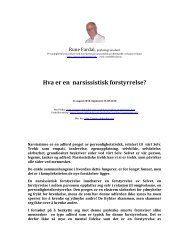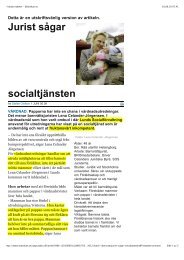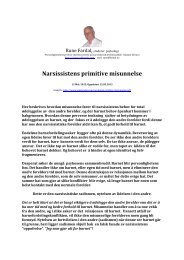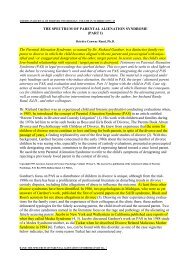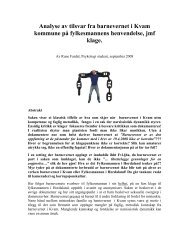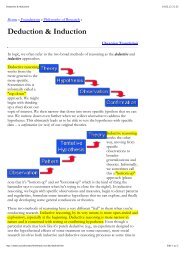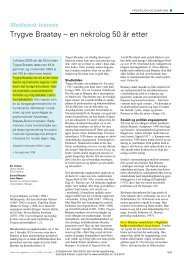The origins of narcissism and narcissistic personality disorder a
The origins of narcissism and narcissistic personality disorder a
The origins of narcissism and narcissistic personality disorder a
Create successful ePaper yourself
Turn your PDF publications into a flip-book with our unique Google optimized e-Paper software.
THE ORIGINS OF NARCISSISM 81<br />
one’s needs for or ties to significant objects. Or one can diminish <strong>and</strong><br />
efface oneself, elevate one’s object ties, <strong>and</strong> attempt to merge with a<br />
totality-in short, create an oceanic fusion. <strong>The</strong> former strategy attempts<br />
to eliminate division <strong>and</strong> separateness by taking the viewpoint<br />
<strong>of</strong> subjective self-awareness <strong>and</strong> by attempting to ignore the withering<br />
glare <strong>of</strong> objective self-awareness; it reduces shame through self-inflation<br />
<strong>and</strong> an elevation <strong>of</strong> self-esteem (Bach, 1985; Broucek, 1982; Kinston,<br />
1983, 1987). Within the realm <strong>of</strong> normal behavior, this strategy<br />
leads to assertiveness <strong>and</strong> competitiveness, as well as to self-enhancing<br />
biases. At a pathological level, this increased self-esteem is termed<br />
gr<strong>and</strong>iosity or exhibitionism. <strong>The</strong> latter strategy, self-effacement, copes<br />
with the experience <strong>of</strong> division by adopting the viewpoint <strong>of</strong> objective<br />
self-awareness, by attempting to annul one’s subjectivity <strong>and</strong> vitality;<br />
it reduces shame through a diminution <strong>of</strong> self-esteem, through an effort<br />
to hide, <strong>and</strong> through an idealization <strong>of</strong> the other (Bach, 1985; Blatt,<br />
1983; Broucek, 1982; Kinston, 1983, 1987). Within the normal range,<br />
this strategy is associated with cooperativeness, politeness, <strong>and</strong> modesty.<br />
At a pathological level, these efforts are termed compliance, submissiveness,<br />
or even masochism. Ultimately, concepts like infantile<br />
omnipotence or normal symbiosis, among numerous others <strong>of</strong> equally<br />
questionable validity, derive from a wish for a state not only without<br />
reflexive self-awareness but indeed without tensions. Such concepts,<br />
in other words, reflect <strong>narcissistic</strong> fantasies-illusory attempts to annul<br />
division <strong>and</strong> separateness, to create a sense <strong>of</strong> oneness that never was.<br />
Reflexive Self-Awareness <strong>and</strong> Pathological Narcissism<br />
Returning to questions <strong>of</strong> <strong>narcissistic</strong> <strong>personality</strong> <strong>disorder</strong>, one can see<br />
the points <strong>of</strong> continuation between normal forms <strong>of</strong> self-awareness<br />
<strong>and</strong> self-representation <strong>and</strong> manifestations that are pathological-between<br />
subjective self-awareness <strong>and</strong> gr<strong>and</strong>iose exhibitionism on the<br />
one h<strong>and</strong> <strong>and</strong> between objective self-awareness <strong>and</strong> <strong>narcissistic</strong> depletion<br />
on the other. Narcissistic <strong>personality</strong> <strong>disorder</strong> involves an impairment<br />
in evocative constancy that is similar to but less severe than<br />
the representational disturbance that many theorists (Adler & Buie,<br />
1979; Blatt & Shichman, 1983; Masterson & Rinsley, 1975; Modell,<br />
1963; Rinsley, 1982) attribute to the borderline disturbances. Evocative<br />
representational constancy is the ability to evoke images either <strong>of</strong> a<br />
cohesive, effective self or <strong>of</strong> a nurturing, constant object during periods




